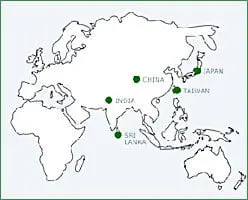Your basket is currently empty!
Where is tea grown?
It is principally grown in sub-tropical countries of the Far East and East Africa.
Tea producing countries such as China, India, Sri Lanka (Ceylon) and Japan immediately come to mind. Their tea growing areas are generally hot, humid with high rainfall and have acidic soils. Many of the best teas are from higher altitudes where dramatic changes of temperature and wind bring distinctive characteristics to the taste of these teas. Where is tea grown? is a question which today has a more complex answer however. We source our teas from all the principal tea growing countries and areas of the world as well as from some rather less well known areas that produce excellent, distinctive tea. Where is tea grown – a matter of nature and trade.
China, the home of tea from where the native tea plant grows in the wild. The most celebrated tea growing area in China is the ‘golden triangle’ formed by the mountains of Huang Shan, Mogan Shan, Qi Shan and Tian mu Shan.

Anhui province is famous for its black Keemun known by some as the ‘Burgundy of teas’. These teas were England’s favourite in the 1800s. Yunnan Province produces black teas with distinctive earthy teas of the same name, and Fujian province from where unique Lapsang Souchong tea originates. Most tea grown in China is green. We stock a large range of Green China tea. White tea originates from Anhui Province in China. We stock several traditional budset and leaf style white teas. See our page about Chinese Tea and our page on the Chinese tea growing areas.
India is known for robust Assam teas, grown in the Brahmaputra valley. These are generally drunk with milk. Darjeeling, around the famous ex-British hill station in the Himalayas produces light afternoon teas known as the ‘Champagne of Teas’. In the Western Ghats, to the south of India, are the Nilgiri Hills which produce highly acclaimed Nilgiri Teas. We offer some rare and distinctive orthodox teas from Arunachal Pradesh, the most north-easterly of India’s states. Read our blog article about them here.
Sri Lanka is source of the much admired and distinctively fragrant Ceylon Teas. Their high-grown teas, especially those from the central Nuwara Eliya district are particularly admired. We stock teas from the principal tea growing areas: Nuwara Eliya, Dimbula, Uva and Kandy.
Japan is renown for its green sencha, courser bancha and matcha. Initially they took their tea making and consumption traditions from the Chinese but soon developed their own styles and indeed, the Japanese Ceremony is unique to this country. These have a more grassy, vegetal style than the cleaner tasting China green teas. See our Japanese Teas.
Tea is also notably grown in these countries
Nepal, also in the Himalayas, has a loyal following. Geographically, Nepal is close to Darjeeling in India so the two areas share some qualities in the style of teas they produce. Both use the more delicate tasting and smaller leaf Chinese variety of Camellia sinensis. We stock very good Nepalese tea grown in the east of the country. Since the privatisation of their tea gardens Nepal produces excellent quality orthodox teas at high altitude of a Darjeeling character.
Taiwan, originally known as Formosa, is highly regarded for its oolong teas. See our Oolong Teas page.
Vietnam has been producing tea for centuries and has been exporting it since the start of the 19th century. It is particularly suited to producing oolongs of which we have a high quality rolled example.
Kenya is generally known as the source for most of our well known, branded tea blends. These tend to be small leaf CTC (Cut Tear Curl). However, we are pleased to stock two unusual large leaf orthodox teas. See our Kenyan Black Tea.
Rwanda in central Africa, particularly mountainous in the west has highly fertile volcanic soils at high altitude perfect for good quality tea production. The teas are golden and flowery of which we have a good example from the Rukeri garden.
Tanzania in East Africa now produces a little high quality orthodox tea. Privatisation and research into clonals and soil and water conservation is helping this. We stock a green tea and an oolong from the Usambara Mountains in the Masai Steppe.
